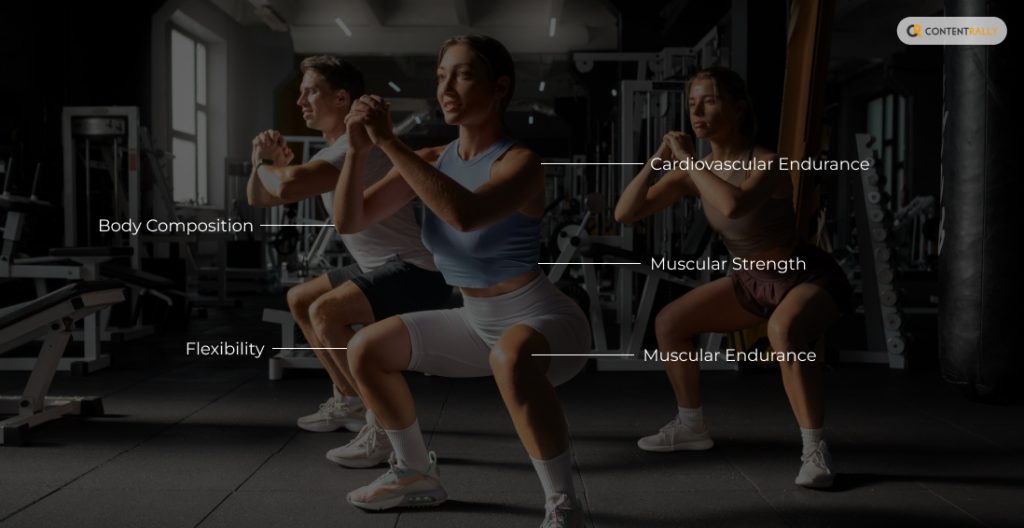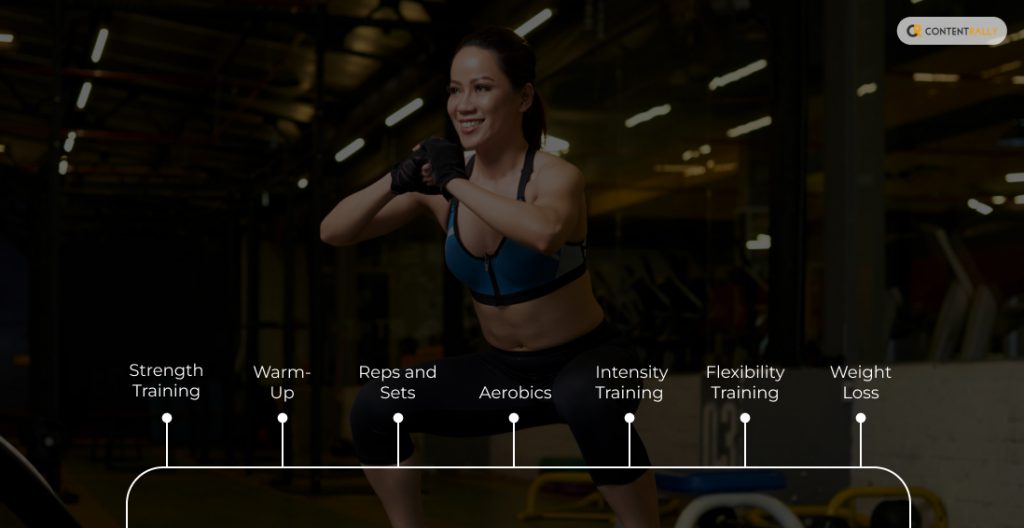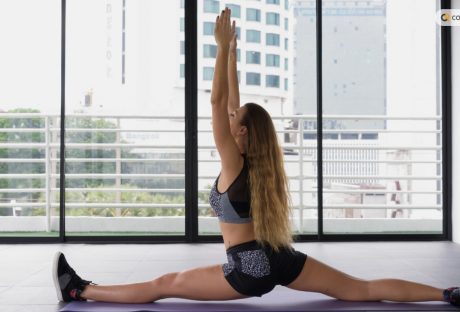You must understand the fundamentals of fitness if you want to have a healthier lifestyle. Actually, physical fitness is crucial for a healthy lifestyle. In fact, with good physical fitness, you can not only stay in shape, you can increase your energy levels and reduce risks of illness. This is where you must know what are the 5 components of fitness.
In this article, you will learn what are the 5 components of fitness. Here, you will get a brief description of each of these components and the steps you must take for these components. Moreover, you will also learn a way to integrate all these components into a single fitness plan. Hence, to learn more, read on to the end of the article.
What Are the 5 Components of Fitness?

The following are the five components of fitness that you must be aware of:
1. Cardiovascular Endurance
If your body is able to use and deliver oxygen to your muscles when you are doing physical activity, it means you have cardiovascular endurance. This is one of the most crucial factors that ensure your heart health. Also, it affects blood vessels and can help you to prevent type 2 diabetes.
To boost cardiovascular endurance, you must engage in aerobic fitness activities like jogging, swimming, and cycling. Basically, you can do this in various intensities and focus on long and continuous movements.
With good cardiovascular endurance, you can promote better heart health. Moreover, it also contributes a lot to mental health, well-being, and fitness.
2. Muscular Strength
Muscle strength is the maximum force that a muscle (or a group of muscles) exerts in a single effort. Basically, you can use this strength when you lift heavy objects. Apart from that, you can also require muscle strength to perform household chores or to carry groceries.
In fact, your body needs your muscles to generate enough force to handle your body weight. Hence, it is a good thing to have optimum muscle strength.
One of the best ways to enhance your muscle strength is to do body-weight training. On the other hand, you can also lift weights to increase your muscle strength. However, in both cases, proper nutrition is crucial, as it will act as fuel for your body.
3. Muscular Endurance
You know that muscle strength is the amount of force that your muscles can exert in a single effort. Meanwhile, muscle endurance is the time up to which your muscles can exert that force. Having a high muscle endurance is really good, which most people do not have. Hence, it is necessary to develop high muscle endurance.
In fact, high muscle endurance can help you run more, climb stairs, or even play with children. Basically, you will not end up exhausting your muscles. Apart from that, there are health benefits of having a high muscle endurance. You can enhance your quality of life and daily living.
Hence, to boost muscle endurance, do more lightweight exercises with more repetitions. For example, do more squats, sit-ups, pull-ups, and running. However, make sure to bring variations in your training and be more consistent.
4. Flexibility
When you are able to move your joints through a full range of motion without any problem or the risk of injury, then you are flexible. Hence, flexibility is an important factor if you want full-range fitness.
Hence, to become more flexible, consider practicing yoga, dynamic stretching, Wall Pilates, and static stretching. Make sure to practice them daily for the best results.
If you have good flexibility, it will lead to better overall physical well-being. Then, it will not only improve your posture but will also reduce the risk of injuries. Apart from that, good flexibility also enhances athletic performance and daily activities and movements.
5. Body Composition
This is the ratio of fat and non-fat mass in your body. Basically, it provides good information about your fitness level. This information includes the amount of body fat, bone, muscle mass, and water in your body.
Basically, you can assess your body composition by calculating your body mass index (BMI) as well as your body fat percentage. In fact, once you understand your body composition, you can set your fitness goals accordingly. This way, you can reduce your body fat and increase the proportion of your lean muscles.
On the other hand, if you want to reduce the risk of health issues, it is important to ensure balance in your body composition. For instance, if you have a high body fat percentage, you might have various health problems (for example, heart disease).
Integrating the 5 Components into a Fitness Plan

To work on all the five components of fitness, you must integrate them into your fitness regime. Hence, it is important to create a workout plan that balances these components and is quite effective. Basically, to work towards a full-body transformation, you have to merge strength training exercises with aerobic activities.
Here is a basic idea of a fitness plan with a balanced exercise routine:
1. Strength Training
To ensure muscle strength, you must target major muscle groups. Hence, you must incorporate exercises like squats, bench presses, and bicep curls.
2. Warm-Up
If you want to perform intense exercises, you must start with a warmup, which will prepare your body. For instance, before you start intense training, make sure to do light jogging or dynamic stretching.
3. Reps and Sets
To enhance muscle strength and endurance, you can aim for three sets of 12 repetitions for each exercise.
4. Aerobics
Aerobics can help you improve your cardiovascular endurance. Hence, you can include exercises like running, swimming, cycling, etc.
5. Intensity Training
Depending on the intensity of your fitness regime, you can choose different levels of intensity. For instance, you can include a gentle jog, or you can even go for high-intensity interval training.
6. Flexibility Training
By including a full range of motion in your fitness, you can reduce the risk of injury. Hence, you can incorporate stretching exercises or yoga to enhance flexibility.
7. Weight Loss
If your goal is to lose weight, you must combine higher-intensity cardiovascular exercises with a diet that is healthy for your heart.
How Can Monitoring Heart Rate Enhance Training and Fitness?

You must monitor your heart rate from time to time if you are serious about your fitness. In fact, it is crucial to consider your heart rate since it is your body’s response to physical activity.
The following are the advantages you will benefit from if you keep an eye on your heart rate:
- Intensity Gauge: Once you observe your heart rate from time to time, you can understand your exercise’s intensity. In this case, if your heart rate is too high, it means that you are overexerting yourself. However, if your heart rate is low, you have to push a bit harder.
- Performance Tracking: By monitoring your heart rate, you can understand improvements in your fitness. Hence, you will have a better idea of whether to make adjustments in training or not.
- Safety: If your heart rate is within a safe range, it shows that there is no unnecessary strain on your heart. Hence, it aligns with the best practices of cardiovascular health.
How Can Regular Fitness Support Your Heart?

If you engage in regular fitness activities, you are not only working towards your fitness goals but also taking care of your overall health. This also includes your heart health. Here are some of the benefits of regular fitness:
- Low Risk: If you do daily exercise, it will strengthen your heart muscles. Apart from that, it will also improve your blood flow. Apart from that, it will also aid in weight loss. Hence, all these factors will contribute to a healthy heart.
- Holistic Approach: Getting a healthy heart is not just about cardio, it is also about getting a holistic approach to your fitness. For instance, you have to include strength training, intensity training, flexibility training, and the right nutrition.
- Long-Term Benefits: If you are into regular fitness, you can work on your long-term health. This will keep your heart healthy for a long time.
Plan Out Your Fitness Regime Now
“What are the 5 components of fitness?” – Now you know the answer to this question. To ensure all-around fitness, you have to consider muscle strength, muscle endurance, heart health, flexibility, and body composition. Once you understand and incorporate all these elements in your fitness regime, you can ensure long-term fitness.
Do you have more suggestions on how to plan a fitness regime? Please share your ideas and opinions in the comments section below.
Read Also:




















